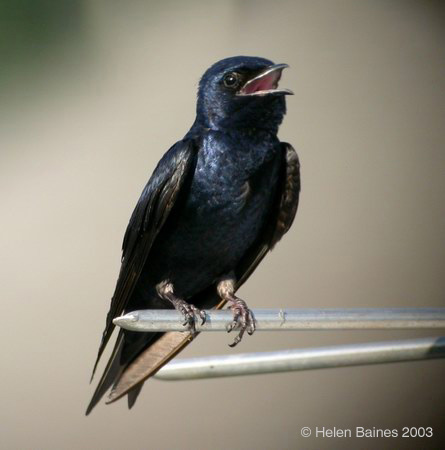- Progne subis
Photographed near Houston, Texas, USA.
Identification
7-8 1/2" (18-22 cm). Adult male dark steel-blue. Female and immature male duller above, pale gray below. Overhead, similar in shape to European Starling, but flight more buoyant and gliding.
The Purple Martin (Progne subis) is the largest North American swallow at 20 cm length. Adults have a slightly forked tail. These "aerial acrobats" have speed and agility in flight, and when approaching their housing, will dive from the sky with their wings tucked at great speeds.
Proper identification of Purple Martins is determined by their age. It takes two years for this species to reach their full adult breeding plumage. This makes identification complicated. There are some common acronyms used in identifying the age and sex of Purple Martins. "HY" means "hatching year", "SY" means "second year" and "ASY" means "after second year".
ASY (adult birds) Adult males are entirely black with glossy steel blue sheen, and adult females are dark on top with some steel blue sheen, and lighter underparts.
SY (subadult birds) Females look similar to "ASY" females minus the steel blue sheen on the back. Males look very much like females at this age, but they will have solid black feathers starting to emerge on their chest in a blotchy, random pattern as they moult to their adult plumage.
Distribution
Breeds from British Columbia, central interior Canada, and Nova Scotia southward, but absent from interior western mountains and Great Basin. Winters in tropics. Their breeding habitat is open areas across eastern North America, and also some locations on the west coast from British Columbia to Mexico. It is seldom found in Florida (AOU 2000). This species typically breeds in colonies located in close proximity to human housing.
Taxonomy
Habitat
Open woodlands, residential areas, and agricultural land.
Behaviour
Purple martins are aerial insectivores, meaning that they catch insects from the air. The birds are agile hunters and eat a variety of winged insects. Rarely, on occasion, they will come to the ground to eat insects. They usually fly relatively high, so, contrary to popular opinion, mosquitos do not form a large part of their diet.
The call is described as: "Throaty and rich tchew-wew, etc., or pew pew. Song gurgling, ending in a succession of low rich gutturals".[
4 or 5 white eggs in a mass of grass and other plant material placed in a cavity - sometimes a hole in a tree or a martin house with many separate compartments, where the birds nest in a colony.
Its voice is a liquid gurgling warble. Also a penetrating tee-tee-tee.
The custom of erecting a martin house to attract these beneficial birds was practiced by the early settlers and, before them, by the southern Indian tribes, who hung clusters of hollow gourds in trees near their gardens. In other areas, the species nested in tall dead trees riddled with woodpecker holes, but these original colonies never reached the size -- as many as 200 pairs -- of colonies found in large martin houses today. In the West, it tends not to occupy martin houses, preferring the open countryside or downtown areas, and is becoming scarcer, probably due to competition with European Starlings for nest sites.




